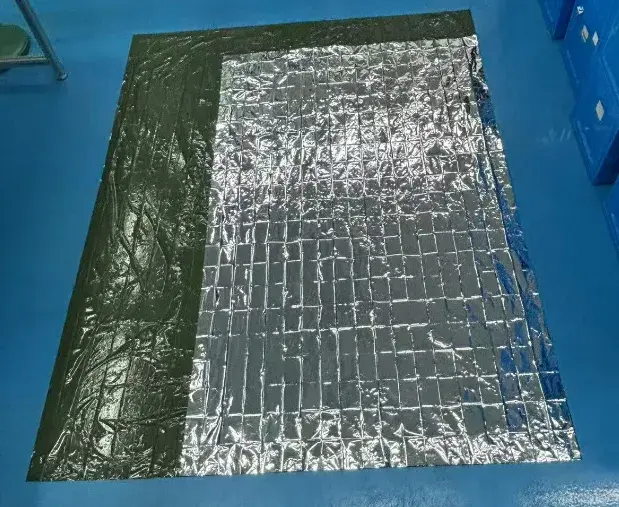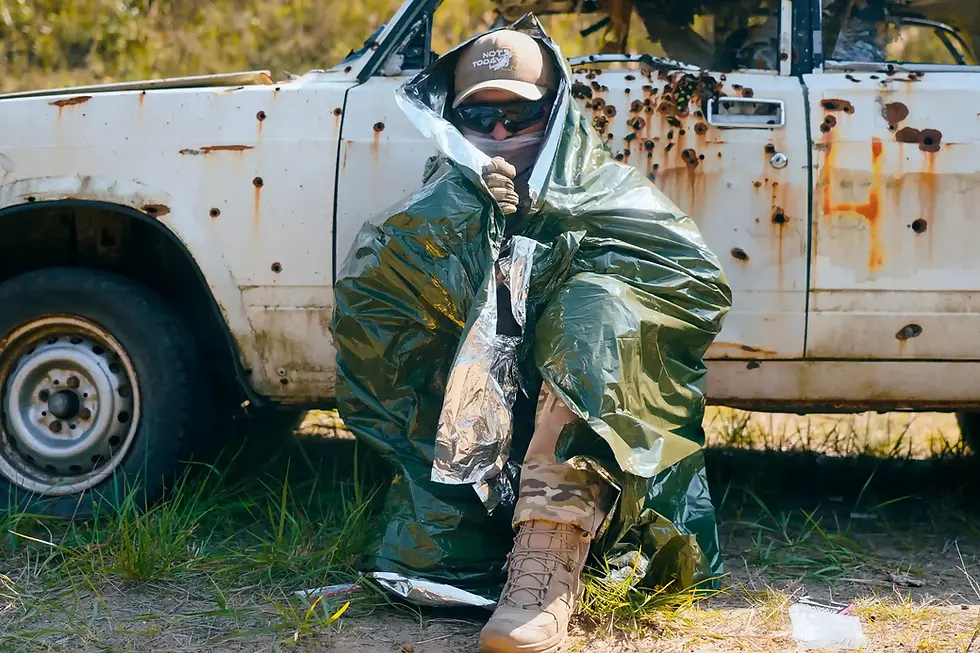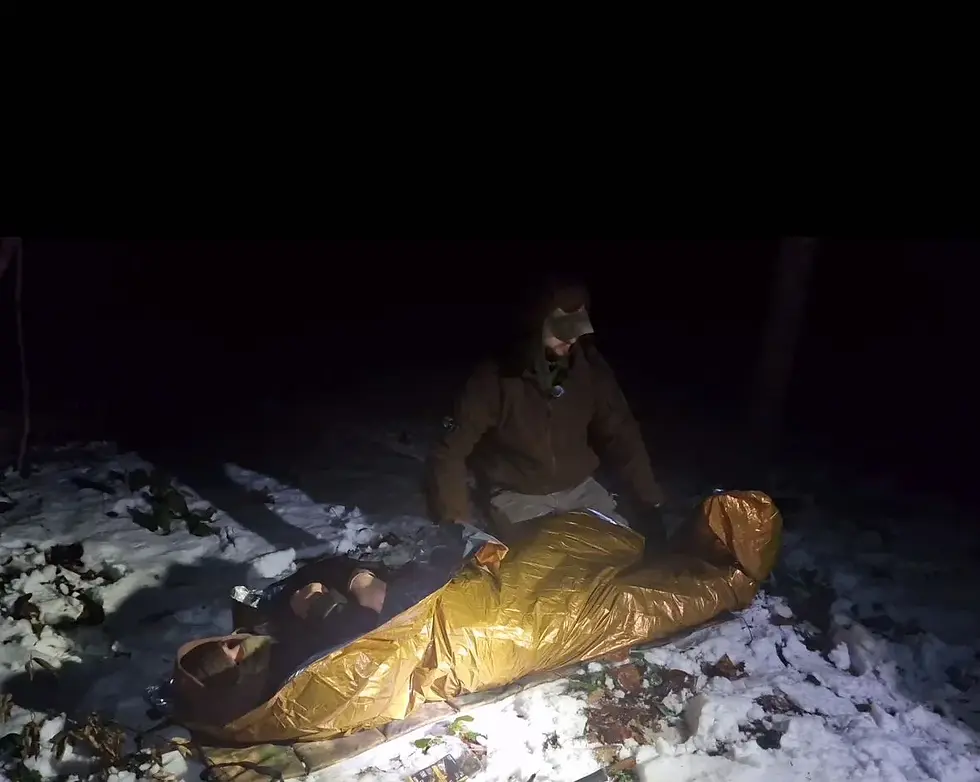10 Survival Uses for Emergency Blankets That Could Save Your Life
- YEYETAC™

- Aug 20
- 6 min read
Updated: Sep 25

When sudden weather changes occur in remote locations, having the right emergency gear becomes critical. During harsh conditions, an emergency blanket often proves to be the most valuable piece of equipment for survival situations.
Emergency blankets (also called space blankets) serve multiple critical survival functions beyond basic warmth, including: creating shelters, collecting water, signaling rescuers, preventing hypothermia, protecting gear, preserving food, reflecting heat, providing shade, creating secure food storage, and serving as an emergency medical tool.
These lightweight, compact sheets should be in every tactical medical kit, bug-out bag, and vehicle emergency kit. At YEYETAC™, extensive field-testing of these applications has been conducted and incorporated into tactical medical training programs worldwide.
Types of Emergency Blankets
Before exploring survival applications, understanding the different types of emergency blankets available is essential for proper selection.
Standard Space Blankets
Standard thin space blankets are typically made from polyester film with an aluminum layer that reflects up to 90% of body heat. Weighing approximately 2 ounces (56g), these economical options are lightweight but tear easily and are generally single-use.
This variety represents the most common emergency blanket type available. Despite limited durability, their lightweight properties and cost-effectiveness make them standard inclusions in most basic first aid kits. For short-term emergency situations, this type is sufficient to address fundamental needs.
Heavy-Duty Emergency Blankets
Tactical-grade durable emergency blankets feature thicker materials, often with nylon fiber reinforcement layers, reinforced edges with grommets, superior tear-resistance, and multi-use capability - ideal for long-term survival scenarios and harsh environments.

Professional users should select blankets meeting military specification MIL-STD-810, ensuring performance under extreme temperatures, moisture, and mechanical stress. While tactical emergency blankets command higher prices, their reusability and reliability prove essential for serious survival preparation.
10 Proven Survival Uses for Emergency Blankets
1. Creating a Waterproof Emergency Shelter
Emergency blankets make excellent improvised shelters by stringing cordage between trees at shoulder height, draping the blanket over to form an A-frame, and securing corners with rocks or stakes. Position the reflective side inward to maximize retained body heat.
The key advantage here is speed - a functional shelter can be constructed in under 5 minutes with minimal materials. Top-quality tactical blankets with reinforced grommets make this even easier by providing secure attachment points that resist tearing in high winds. When building, ensure one end is slightly higher than the other to facilitate water runoff and prevent structural collapse from pooling.
2. Collecting and Storing Water
Emergency blankets efficiently collect rainwater by stretching the blanket in a shallow depression with edges secured using rocks, creating a collection point in the center. For dew collection, lay the blanket over vegetation overnight and collect condensation in the morning.
In desert environments, this technique has yielded up to 2 liters of water from overnight dew, potentially making the difference between dehydration and survival. The non-porous surface of quality emergency blankets ensures that all collected water remains available rather than being absorbed. Collected water should be filtered or purified, using portable filters or simple sedimentation to remove larger particulates.
3. Creating High-Visibility Rescue Signals
Emergency blankets make powerful visual signals visible for miles when properly deployed. Secure the blanket on elevated ground with its reflective side facing the sun to create flashes visible to aircraft, or position perpendicular to likely rescue routes for ground searchers.

During search and rescue operations, emergency blanket signals have been spotted from over 8 miles away in clear conditions. The distinctive flash created by sunlight hitting the reflective surface immediately draws attention in ways that other signals cannot match, especially in heavily wooded areas. The internationally recognized distress signal is three short-interval signals, so controlling reflection flashes rhythmically can clearly communicate distress.
4. Preventing Hypothermia Through Body Wrapping
For maximum warmth, wrap the emergency blanket with the reflective side facing inward toward the body, ensuring complete coverage including the head while leaving only the face exposed. Create a sealed envelope by tucking edges underneath the body.

This technique can increase microclimate temperature by 10-15°F (5-8°C) within minutes. The most common mistake is improper orientation - the reflective side must face the body to reflect radiant heat back, not face outward as many mistakenly believe. In severely cold conditions, this technique can extend survival time from hours to overnight, providing precious time for rescue efforts.
5. Protecting Food from Wildlife
Create an effective bear bag by wrapping food, toiletries and scented items in an emergency blanket before suspending from a tree branch at least 10 feet high and 4 feet from the trunk. This contains food odors while protecting supplies from moisture and small animals.
While not a replacement for proper bear canisters in high-risk areas, this method provides significantly better protection than standard stuff sacks alone. The non-breathable material helps contain food odors that would otherwise attract wildlife to camp. This technique is particularly important in North American wilderness areas, where bears can detect food odors from miles away, and bear encounters represent a major risk factor for outdoor enthusiasts.
6. Waterproofing Backpacks and Gear
Protect non-waterproof backpacks and sensitive gear by wrapping them completely in an emergency blanket, folding edges to create waterproof seams, and securing with cordage. This creates an effective moisture barrier during unexpected precipitation.
During a river crossing incident, emergency blanket-wrapped communications equipment remained completely dry despite full submersion. This level of protection often exceeds what standard pack covers provide, particularly in driving rain or when fording water obstacles. Electronic devices, fire-starting materials, and medical supplies particularly benefit from this enhanced protection, as these items may become completely non-functional when wet.
7. Preserving Food in Survival Situations
Create an effective meat smoking system by constructing a rack over a small fire and enclosing it with an emergency blanket (reflective side in) to contain smoke and reflect heat. This accelerates the smoking process while using less fuel.
In field tests, this method reduced smoking time for meat preservation by approximately 40% compared to open-air smoking, while also providing better protection from insects. The reflective surface concentrates heat while the enclosed space maintains consistent smoking conditions. Smoked meat can be preserved for 2-3 days in moderate climates, significantly extending food supplies in wilderness situations.
8. Reflecting Campfire Heat
In desert or hot conditions, suspend an emergency blanket above the rest area with the reflective side facing upward. This reflects solar radiation away and can reduce temperatures in the shaded area by up to 15°F (8°C).
During desert training operations, this technique has proven invaluable for preventing heat casualties. The difference in temperature between standard natural shade and emergency blanket-enhanced shade is immediately noticeable and can make hostile environments significantly more survivable. Heat stroke represents one of the deadliest threats in outdoor activities, and this simple technique can dramatically reduce risk, especially in open areas lacking natural shade.
9. Creating Shade in Hot Environments
Maximize campfire warmth by positioning an emergency blanket vertically behind the fire (opposite the seating position) with the reflective side facing toward the individual. This reflects significant heat that would otherwise be lost, effectively doubling the perceived warmth.
This configuration not only increases warmth but also reduces fuel consumption by making more efficient use of the fire's radiant heat. In tactical situations, this allows for smaller, less visible fires while maintaining necessary warmth in cold environments. Testing shows this configuration can improve effective heat utilization by approximately 60%, significantly reducing fuel requirements.
10. Improvising Emergency Medical Tools
Emergency blankets can serve multiple medical functions including: as a waterproof trauma pad backing, an improvised CPR barrier, a sling for injured limbs, a hypothermia wrap for shock victims, or as a clean surface for treating injuries in field conditions.

In tactical medicine, emergency blankets are routinely incorporated into treatment protocols. Their waterproof, clean surface makes them ideal for creating sterile work areas when treating injuries in austere environments, while their reflective properties help maintain patient temperature during shock treatment. A single tactical blanket can temporarily substitute for multiple specialized medical supplies such as wound coverings, blankets, and folding stretchers when formal medical equipment is unavailable.
Conclusion
Emergency blankets deliver value far beyond their minimal weight and cost. By understanding these multiple applications, a simple item transforms into a versatile survival tool that addresses shelter, water, signaling, protection, temperature management, and emergency medical needs. Don't wait for an emergency to occur - equip yourself today with YEYETAC™ tactical emergency blankets for your professional team or organization. Contact us at support@tacticalmedicalkit.com to discuss bulk orders and custom solutions for your specific operational requirements. Your preparedness could be the difference between life and death in critical situations.
FAQs
What's the difference between standard and tactical emergency blankets?
Standard emergency blankets are typically single-use, thin metallized plastic sheets, while tactical versions feature reinforced edges, grommets for secure attachment points, more durable materials, and often come in military-appropriate colors rather than just silver.
How long do emergency blankets last in storage?
Quality emergency blankets can last 5+ years in storage if kept in their original packaging in a cool, dry place. Vacuum-sealed tactical blankets have even longer shelf lives, making them ideal for long-term emergency kits.
Can emergency blankets block thermal imaging detection?
Yes, when properly deployed, emergency blankets can help mask your heat signature from thermal imaging devices by reflecting body heat inward instead of allowing it to radiate outward, making them useful in tactical scenarios.
Are emergency blankets flammable?
Standard emergency blankets can melt or catch fire if exposed directly to flame or excessive heat. Keep them at least 24 inches from open flames when using them to reflect campfire heat to prevent damage or potential fire hazards.
How do I properly fold an emergency blanket for reuse?
For maximum reusability, clean the blanket of debris, fold along original creases when possible, avoid sharp creasing that might create tears, and store in a ziplock bag away from sharp objects. Tactical-grade blankets can typically be reused 5-10 times with proper care.




Comments